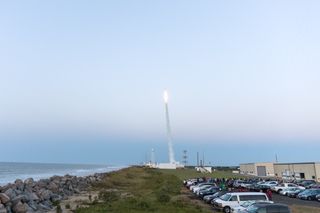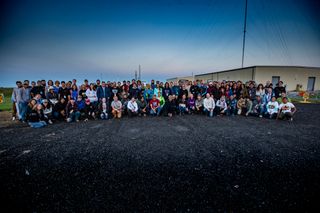Rocket On! These Cool Student Experiments Just Launched to Space
Dozens of students got to see their experiments travel from school to space. A sounding rocket soared from a NASA rocket facility in Virginia Tuesday (Aug. 14), carrying several student experiments under the RockSat-X program, in collaboration with the Colorado Space Grant Consortium.
The mission took place at NASA's Wallops Flight Facility in Virginia, beginning with a flawless liftoff at 6:14 a.m. EDT (1014 GMT). The payload reached a maximum altitude of 98.5 miles (158.5 kilometers) before splashing down as planned in the Atlantic Ocean, about 64 miles (103 km) from the launch site. The experiments and data were expected to be recovered by sea the same day.
"Participating students are able to apply what they learn in the classroom into a hands-on project," Giovanni Rosanova, chief of the Sounding Rockets Program Office at Wallops, said in a statement from NASA. "To be a part of this process is rewarding to everyone involved in RockSat-X at Wallops. [NASA's Small Rocket Launches in Awesome Photos]

RockSat-X is the most advanced of a three-tier program that helps students learn how to build experiments for spaceflight. The other tiers are called RockOn and RockSat-C.
"It's amazing to see students progress through [the] RockOn and RockSat process," Chris Koehler, director of the Colorado Space Grant Consortium, said in the same statement. "They are able to increase their skill levels — skills that industry and government organizations seek."

Here's a brief description of each participating institution's work:
- Several Colorado community colleges – Orbital Scrap Capture and Reclamation: This is a payload that generated an electrostatic field that can pick up small pieces of aluminum debris, using a rod with rabbit fur. The eventual application is for space debris. Participating institutions include Arapahoe Community College, Community College of Aurora and Red Rocks Community College.
Get the Space.com Newsletter
Breaking space news, the latest updates on rocket launches, skywatching events and more!
- Capitol Technology University – Project Janus: This project measures cubesat speeds in a satellite constellation, using laser ranging.
- Temple University: This team is studying cosmic radiation at different altitudes, particularly in terms of flux and angular distribution.
- University of Colorado Boulder – Measuring Emitting Ground stations using Antennas Listening for Oscillating Doppler Outputs from NEXRAD (MEGALODON): This experiment measures the radio signals from a doppler radar network called NEXRAD, to see how quickly the signals drop off at higher altitudes.
- University of Maryland – Stratification and Tribocharging Analysis of Regolith (STAR): This experiment measures the electrical charge building up on a regolith simulant in the space environment.
- University of Maryland – Space Characterization and Assessment of Manipulator Performance (SCAMP): A robotic manipulator is being tested for stability, for a satellite servicing rocket experiment being designed at the university.
- University of Puerto Rico: This experiment collects micrometeorites at an altitude of between 50 and 70 miles (80 to 110 km), searching particularly for organic molecules such as DNA, RNA and nucleic acids.
- Virginia Tech – ThinSat: Three ThinSats were deployed to study UV radiation, ionizing radiation, radio transmissions and reaction wheel stabilization. This project includes collaboration with Blacksburg High School.
- West Virginia Collaboration: This experiment included participation from several postsecondary institutions. Hobart and William Smith Colleges were interested in measuring payload vibration. Marshall University tested an automatic target acquisition system with target stars. West Virginia State University tested designs and interferometry for future cubesat missions. West Virginia University tested a capsule designed to protect experiments, as well as an advanced plasma spectrometer. West Virginia Wesleyan College tested solar panel technology and the validity of magnetometer data from the National Oceanic and Atmospheric Administration.
The next flight of the RockSat-X program, called RockSat-XN, will launch from the Andoya Space Center in Norway in January 2019. It will include experiments developed by students in the United States, Norway and Japan.
Follow us @Spacedotcom, Facebook and Google+. Original article on Space.com.
Join our Space Forums to keep talking space on the latest missions, night sky and more! And if you have a news tip, correction or comment, let us know at: community@space.com.

Elizabeth Howell (she/her), Ph.D., was a staff writer in the spaceflight channel between 2022 and 2024 specializing in Canadian space news. She was contributing writer for Space.com for 10 years from 2012 to 2024. Elizabeth's reporting includes multiple exclusives with the White House, leading world coverage about a lost-and-found space tomato on the International Space Station, witnessing five human spaceflight launches on two continents, flying parabolic, working inside a spacesuit, and participating in a simulated Mars mission. Her latest book, "Why Am I Taller?" (ECW Press, 2022) is co-written with astronaut Dave Williams.
Most Popular


